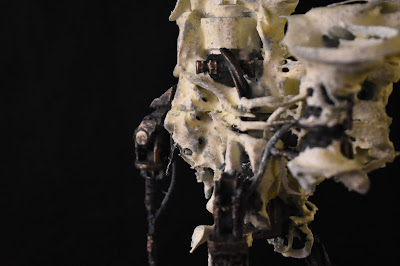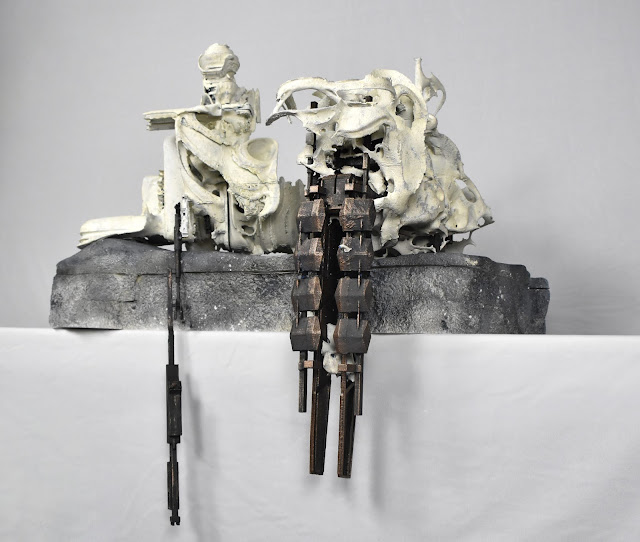Process
T4T LAB 2019 Texas A&M University. Invited Professor: Joris Putteneers.
Team: Garrett Farmer, Sephora Belizor, Andrew Atwood, Marie Chapa and Julia Vasilyev
This project is an exploration of post-singularity and
it’s post-anthropocentric ecology. The post-singular
reality we express, exists once the machine exceeds beyond the author’s intent.
By assuming that the essence of being is to create, consciousness is found when
the machine begins to produce something on its own, non human, agenda. In this case, the result is a new synthetic
biological life formed through molecular reconstruction. Both organic and
inorganic materials are taken from the environment and remodeled at a base
level to produce new synthetic ‘biomaterials’. By introducing these new
materials as resources, the machine now calls for and begins to implement a new
ecology that is built without cognitive human bias or agency. Ethics come into
question as the security of regulating our own ecology is taken from our hands
and put into the hands of a machine. This enables the transitions into the
Post-Anthropocene in the sense that the machine creates a hyper-efficient
ecology that is inclusive of humans, yet is not limited to agency of the small
(i.e. man), but rather is focused on the agency of the whole.
The post-singular
is expressed as moments in time where artificial intelligence takes agency
beyond that of the human user, letting the machine become the user itself. In the case of this project, the object
embodies the power of collective consciousness to the point of becoming
autonomous and self-serving.
True post-singularity
would come to exist when these systems would have full agency and independence
in choosing their structure as well as producing data of its own to be input.
Having a role of its own in the ecology, the post-singular machine is capable
of viewing objects from a foreign, seemingly unbiased position. This reality
frees itself from the Anthropocene perspective by handing off certain
ecological conflict resolution to the machine. Now, the machine becomes a
self-aware Mediator to the ecology, resolving conflicts in object relations.
The creation and development of the objects started as part of a
digital process, in which the power of artificial intelligence, through
algorithms, were actively present. The
program used to create its base form was set through modifications in
parameters to create a specific algorithm, in a similar way to how the object
is designed to create new biomaterials through reconfiguration at a molecular
level from pre-existing materials. The origin of the machine was intended to be
allopoietic, where its primary focus was strictly on adding and maintaining the
ecology and its data. However, as the machine gains more and more awareness of
itself, it transitions into being autopoietic in order to sort data and
materials in ways that deem the ecology as hyper-sustainable for itself to
grow. These changes in the parameters portray the unpredictability of growth and
development in the digital realm, which could result in endless possibilities
for the development of the object. This implies that the object could react in
a number of different ways as it grows, based on the environment and the
conditions that it is exposed to, allowing for a great range of adaptability to
its surroundings.
Initially, the machine was intended to better the ecology for
human existence by collecting defective materials of the post-anthropocene to
be molecularly reconfigured and sent back out into the environment. To do this
the human gave the machine intelligence through a modified consciousness to
effectively complete its task and to give it awareness of place. However, as
the machine developed, it started to define its own version of a healthy
ecology, making independent decisions to achieve it by utilizing its abilities
to reconfigure its surroundings. The artificial intelligence overcame the
limits of its own consciousness, claiming dominion over nature and developing a
denial of death in the Heideggerian sense. Through this denial of mortality,
the machine is unable to recognize an end, and therefore, no limit of
“technological mastery.”
The process starts by the machine identifying obstacles in the
environment that it must correct, in order to maintain its own idea of a
healthy ecology. A healthy ecology must be maintained in order for the machine
to grow and preserve itself. Once the machine defines a territory it wants to
address, it supplies a minimal framework of parts to build upon in that
specific territory. New iterations of drills can be created in this process. As
the machine evolves in each territory, drills come together to form larger
components as the machine sees necessary. Different parts perform distinct
functions, fitting into each other and mature, creating a larger, complex
framework. Based off of these new parts it is able to regenerate itself in
infinite ways, each time responding to the territory it is addressing. For
example, small drills could extract, test, and inject biometarerial into the
ecology, while larger data processing facilities could mine, process, refine,
and synthesize biomaterial on a large scale. In both cases, each component are
made from a similar original framework, but plug into each to reach new outcomes
based on their individual derived functions.
The drills are mining materials affected by the Anthropocentric
age located on the top soil layers of its environment. These anthropocentric
materials can be classified by the level of transformation or deterioration by
human impact, be it digitally, such as bodyless data pollution, like
electromagnetic rays, or physically like effects from global warming or lithium
mining. These off-site drills then transport themselves back to the data
processing facility, where the mined materials are refined, processed, and
injected with a catalyst, breaking them down and reconstructing them on a
molecular level to create a new biomaterial. The data processing facility
contains a central drill that is able to extract a base material on a large
scale in order to keep up with the demand for the desired biomaterial. The new
biomaterial is stored separately to ferment, due to its unpredictable nature,
as originally defined by the human. Once the biomaterial has matured, it is
extracted by the smaller drills and ejected back into the area from which it
came, thus fixing and creating a new ecology that the machine deems as suitable
for itself to exist.























































